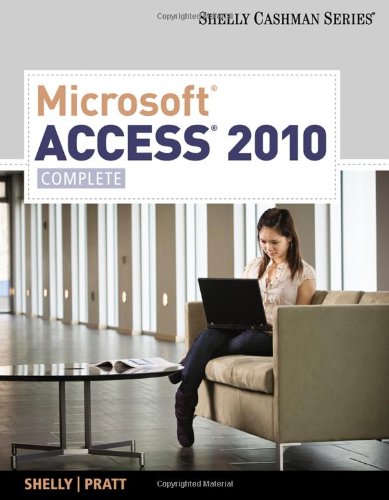

Most ebook files are in PDF format, so you can easily read them using various software such as Foxit Reader or directly on the Google Chrome browser.
Some ebook files are released by publishers in other formats such as .awz, .mobi, .epub, .fb2, etc. You may need to install specific software to read these formats on mobile/PC, such as Calibre.
Please read the tutorial at this link. https://ebooknice.com/page/post?id=faq
We offer FREE conversion to the popular formats you request; however, this may take some time. Therefore, right after payment, please email us, and we will try to provide the service as quickly as possible.
For some exceptional file formats or broken links (if any), please refrain from opening any disputes. Instead, email us first, and we will try to assist within a maximum of 6 hours.
EbookNice Team

Status:
Available4.6
17 reviews(Ebook) Microsoft Access 2010 Complete 1st Edition by Gary B Shelly, Philip J Pratt, Thomas J Cashman, Mary Z Last - Ebook PDF Instant Download/Delivery: 9780538748629 ,0538748621
Full download (Ebook) Microsoft Access 2010 Complete 1st Edition after payment

Product details:
ISBN 10: 0538748621
ISBN 13: 9780538748629
Author: Gary B Shelly, Philip J Pratt, Thomas J Cashman, Mary Z Last
(Ebook) Microsoft Access 2010 Complete 1st Edition Table of contents:
Introduction to the Windows 7 Operating System
Using a Mouse
Scrolling
Shortcut Keys
Starting Windows 7
To Log On to the Computer
The Windows 7 Desktop
Introduction to Microsoft Office 2010
Microsoft Office 2010 Programs
Microsoft Office 2010 Suites
Starting and Using a Program
Access
To Start a Program Using the Start Menu
To Maximize a Window
Saving and Organizing Files
Organizing Files and Folders
To Create a Folder
Folder Windows
To Create a Folder within a Folder
To Expand a Folder, Scroll through Folder Contents, and Collapse a Folder
To Switch from One Program to Another
To Create an Access Database
To Close an Office File Using the Backstage View
Unique Elements in Access
The Access Window, Ribbon, and Elements Common to Office Programs
To Open an Existing Office File
To Display a Different Tab on the Ribbon
To Minimize, Display, and Restore the Ribbon
To Display and Use a Shortcut Menu
To Customize the Quick Access Toolbar
Screen Resolution
To Change the Screen Resolution
Additional Common Features of Office Programs
To Start a Program Using the Search Box
To Open a Recent Office File Using the Backstage View
To Create a New Blank Database from Windows Explorer
To Start a Program from Windows Explorer and Open a File
Moving, Renaming, and Deleting Files
To Rename a File
To Move a File
To Delete a File
Microsoft Office and Windows Help
To Open the Help Window in an Office Program
Moving and Resizing Windows
To Move a Window by Dragging
To Resize a Window by Dragging
Using Office Help
To Obtain Help Using the ‘Type words to search for’ Text Box
To Obtain Help Using the Help Links
To Obtain Help Using the Help Table of Contents
Obtaining Help while Working in an Office Program
Using Windows Help and Support
To Start Windows Help and Support
Chapter Summary
Learn It Online
Apply Your Knowledge
Extend Your Knowledge
Make It Right
In the Lab
Cases and Places
CHAPTER ONE: Databases and Database Objects: An Introduction
Objectives
Introduction
Project — Database Creation
Overview
Designing a Database
Database Requirements
Naming Tables and Fields
Identifying the Tables
Determining the Primary Keys
Determining Additional Fields
Determining and Implementing Relationships Between the Tables
Determining Data Types for the Fields
Identifying and Removing Redundancy
Creating a Database
The Access Window
Navigation Pane and Access Work Area
Creating a Table
To Modify the Primary Key
To Define the Remaining Fields in a Table
Making Changes to the Structure
To Save a Table
To View the Table in Design View
Checking the Structure in Design View
To Close the Table
To Add Records to a Table
Making Changes to the Data
Starting Access and Opening a Database
To Add Additional Records to a Table
To Resize Columns in a Datasheet
Previewing and Printing the Contents of a Table
To Preview and Print the Contents of a Table
Creating Additional Tables
To Create a Table in Design View
Correcting Errors in the Structure
Importing Data from Other Applications to Access
To Import an Excel Worksheet
Additional Database Objects
To Use the Simple Query Wizard to Create a Query
Using Queries
People also search for (Ebook) Microsoft Access 2010 Complete 1st Edition:
access 2010 runtime download
microsoft office 2010 complete set up
microsoft office 2010 full setup
microsoft access 2010 step by step pdf free download
microsoft access 2010 runtime 32 bit
Tags: Gary B Shelly, Philip J Pratt, Thomas J Cashman, Mary Z Last, Microsoft Access